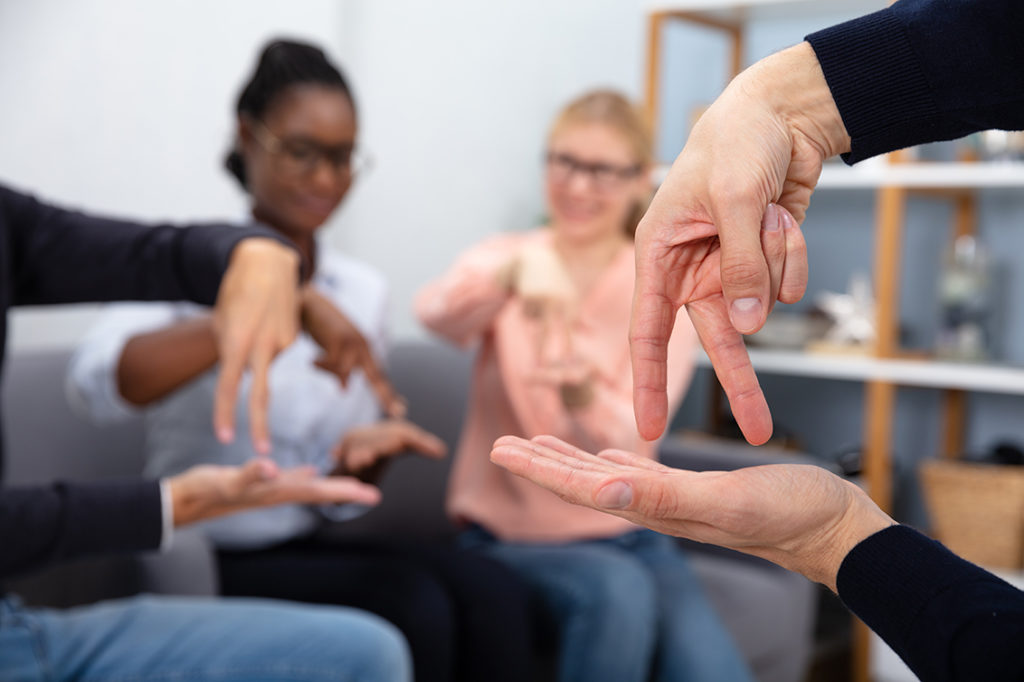BRIDGES connects helping professionals and builds collaboration so that together we break down barriers to providing quality services to Deaf survivors.
Deaf, DeafBlind and hard of hearing (D/DB/HOH) survivors of domestic violence often struggle to get the help they need from many service providers. Survivors encounter serious barriers to communication as well as a lack of understanding of Deaf culture from traditional victim service providers. They also experience ineffective intervention for domestic violence issues within organizations dedicated to serving people with disabilities or Deaf people.
BRIDGES connects helping professionals and builds collaboration so that together we can break down barriers and meet the unique needs of D/DB/HOH survivors. Our co-advocacy approach works in tandem with your program and survivors—bridging the gaps and helping your program navigate challenges and barriers to providing effective services. If your program wants to partner with BRIDGES or needs assistance in working with D/DB/HOH survivors of domestic violence, please contact us today.
You can also take simple steps to learn more about what works and get practical resources and tools to strengthen your program’s work with D/DB/HOH survivors of domestic violence. The information below shares some key things to keep in mind about Deaf culture, communication and how to be an effective ally.
Understanding Deaf Culture
Many Deaf and hard of hearing people identify as members of a distinct cultural group in the United States. Like any other culture, Deaf culture has its own values, norms, community institutions and history that are important to understand and incorporate when serving Deaf survivors.
Deaf victims of domestic violence often face unique circumstances:
- Many Deaf/HOH people don’t identify as having a disability or as experiencing a limitation.
- They identify as a member of a cultural and linguistic group.
- Deaf culture is based on a shared language (ASL) and the common experience of being Deaf in a hearing society.
- Deaf culture has its own values, norms, community institutions and history
As with any culture, Deaf culture is learned and passed down from generation to generation. Most cultures are passed down within families. However, because 90 percent of Deaf people are born to hearing parents, only a small percentage of Deaf people learn their culture from their family. As a result, most Deaf people learn their culture through interactions with their peers and other Deaf people – often in Deaf schools and other community institutions.


Key Parts of Deaf Culture
The primary language for Deaf individuals in the U.S. is American Sign Language (ASL).
- American Sign Language and other countries’ sign languages have grammar and syntax (word order) that differ greatly from spoken and written languages, including English.
- English may be a second language for many Deaf individuals.
- Not all Deaf individuals use ASL, and ASL differs slightly by region of the United States.
- ASL is a visual language:
- Eye contact is extremely important; breaking eye contact or no eye contact may seem like you are ignoring a Deaf person.
- Facial expressions and body language are very important to ASL.
- Deaf people are skilled at using and reading nonverbal communication cues.
Community institutions have played a critical role in the formation of the Deaf community and Deaf culture.
- Examples: Deaf schools, clubs, theater, athletic and political organizations.
- Serve as places for Deaf people to meet and share information and ideas, offer support and socialize.
- May offer the first real chance to meet other people like themselves and feel part of a community.
- Offer a chance to learn Deaf culture and develop their Deaf identity.
While norms may also vary from community to community and person to person, there are some common norms and etiquette that are helpful to know when working with Deaf people.
- Maintaining eye contact
- Being blunt and direct
- Waving, lightly tapping the shoulder, stamping on the floor and turning the lights on and off to get someone’s attention.
- More physically active/expressive during conversations.
- Hugging when greeting or leaving.
- Long goodbyes.
- Being within three feet of proximity for engaging in visual conversations.
History is a central part of every culture. Deaf history includes a broad collection of experiences around community, education, language and culture. Because Deaf Americans have long been isolated from the mainstream hearing society, until the mid-1980s information about Deaf community, culture and history came almost exclusively from outside observers: hearing people who worked with Deaf individuals- educators, doctors, and policymakers. Inspired by the social-political trends of the Civil Rights movement, members of the Deaf community began to look at and establish their own history.
Examples include:
- First signing community.
- Founding of the first Deaf school.
- ASL recognized as a language.
- “Deaf President Now” protest at Gallaudet University.
DeafBlind Culture
The term deaf-blind or DeafBlind refers to a person who has a combined vision and hearing loss. Many people who are deaf-blind identify themselves as being a part of “DeafBlind culture.” However, some do not. Most people who are DeafBlind fall on a spectrum of having some hearing and/or vision that they can use. Most interpreters are familiar with the ideology of viewing deafness from either a medical or cultural perspective. For some DeafBlind individuals, communication involves using tactile methods to access communication and visual information. For others, it involves the use of remaining vision and/or hearing to access communication and information.
Communication Tips
For Deaf individuals
- Keep writing simple. English may not be their first language.
- Reduce visual “noise” when possible, allowing the victim to focus on your questions. Make sure your face and body are illuminated; do not stand in front of a bright light or shine a bright light into their eyes.
- Ask how they prefer to communicate. If requested, follow your organization’s protocol for obtaining a certified sign language interpreter. Do not use a child or family member to interpret.
- When using an interpreter, face the Deaf person and speak directly, using “you” statements instead of “tell him/her.”

For hard of hearing individuals
- Ask how they prefer to communicate. On average, only 30 percent of speech can be read on the lips. Many prefer not to rely solely on lip-reading.
- Reduce background noise when possible. Hard of hearing people often rely on residual hearing for comprehension.
- Rephrase your question if you are not understood the first time. Don’t repeat the same thing over and over.
Important tips
In abusive relationships, the perpetrator will often hide, destroy, or remove the batteries from a technological device (e.g., videophone, cell phone) that the victim uses to contact friends, family and/or emergency assistance. FYI, many videophones require a dedicated remote control in order to dial any number, including 911.
Some people may request a different interpreter even when a qualified one has already been assigned. This can be due to: the client knowing the interpreter on a personal basis (conflict of interest), the client’s inability to understand that particular interpreter’s signing style; or the client’s appraisal that the interpreter is not voicing his/her statements accurately.
If you need an interpreter, check Georgia Registry of Interpreters for the Deaf online for a list of ASL interpreting agencies (click on resource and scroll down to page 7). Talk with your agency about budgeting for interpreters annually; if at times there is a financial hardship, contact BRIDGES and we will try our best to support you in your efforts to provide communication access! Note: BRIDGES does not have interpreters on staff.